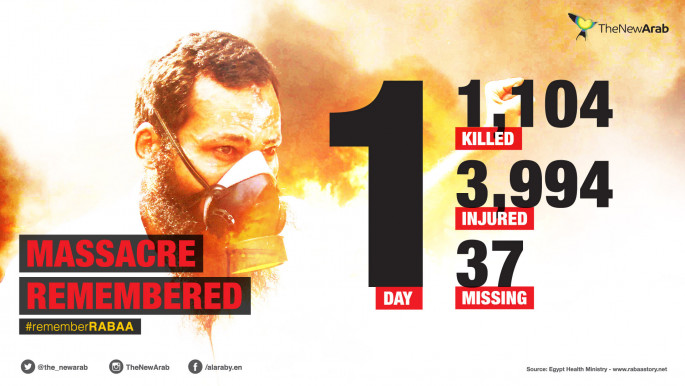Three years on: Remembering the Rabaa massacre
Peaceful sit-ins demanding the reinstatement of Morsi after a military coup had lasted more than six weeks until soldiers began to march towards demonstrators at Cairo's Rabaa al-Adaweya and al-Nahda squares on 14 August 2013.
The date immediately became Cairo's bloodiest day – since the 2011 revolution – as Rabaa square, now renamed after Egypt’s Public Prosecutor, Hisham Barakat, lit up in flames while scenes of chaos covered the once electrifying space.
The main stage – which hosted dozens of passionate activists and speakers for days earlier – burnt to dust, as nearby, a field hospital and a mosque, both of which were used to receive and treat the wounded, were relentlessly razed to the ground by military bulldozers.
As thousands attempted to run for their lives, stenches of death polluted the air while corpses lay scattered across Cairo's streets.
If not bloodied, bodies of the thousands of protesters present were charred, disfigured or missing, medical accounts suggested.
Hundreds of families who have yet to receive the bodies of their loved ones believed they were either detained or killed and buried in mass graves rumoured to exist at a police camp along the Cairo-Suez road.
 |
The Rabaa massacre was one of the world’s largest killings of demonstrators in a single day in recent history - Human Rights Watch |
 |
Though the government categorically denies the existence of a mass grave, if confirmed it would lend weight to the growing number of accusations that the Egyptian regime engaged in crimes against humanity.
Salma Ashraf, a researcher with HRW, said the organisation had documented 140 cases of missing persons, statistics that are almost exactly mirrored by the Wiki Thawra website, which was set up by the Egyptian Centre for Economic and Social Rights.
Out of a total count of 924 protesters missing – according to Wiki Thawra – 693 had been identified and their bodies located, 30 unidentified bodies were buried in state-owned cemeteries, and 14 completely charred bodies were eventually identified through DNA testing. The rest remain unaccounted for.
The vicious raids, which lasted for several hours, were described by HRW as "one of the world’s largest killings of demonstrators in a single day in recent history.”
Egyptian authorities have since adamantly defended their actions by suggesting the protesters were armed and thus responsible for the violence that took place on the day.
Since then, "not a single security officer has been held accountable for the hundreds of deaths and injuries that day," Egypt Campaigner at Amnesty International, Nadine Haddad wrote in her account of the day.
"They put the blame on protestors for violence and shielded the security forces from any criticism."
A brutal crackdown on anti-regime activists and Muslim Brotherhood sympathisers has since taken place.
Since July 2013, more than 30,000 people have been detained and at least 124 have died in detention, either due to torture or poor detention conditions, including a lack of access to medical care in prison, according to Amnesty.




 Follow the Middle East's top stories in English at The New Arab on Google News
Follow the Middle East's top stories in English at The New Arab on Google News


